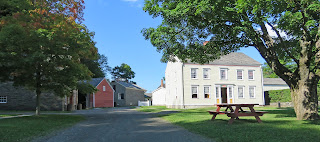 RVs will fit in the parking lot if parked through two spaces. RVs may also be parked at the Yellow Trolley Lot which is less than 1/4 mile to the north. Paths lead from the lot to the museum. Museum 42.71483, -74.92855
RVs will fit in the parking lot if parked through two spaces. RVs may also be parked at the Yellow Trolley Lot which is less than 1/4 mile to the north. Paths lead from the lot to the museum. Museum 42.71483, -74.92855Saturday, September 24, 2022
Farmers’ Museum
The museum property has been a working farm since 1813. It was originally owned by James Fenimore Cooper, author of the popular Leatherstocking Tales, then by Judge Samuel Nelson who bought it in 1829. By the 1870s it had been bought by Edward Severin Clark, an heir to the Singer Manufacturing Company fortune, who had a mansion and a showcase farm with a barn, creamery, and herdsman’s cottage constructed of local stone. Today the farm is run by a private organization as a nonprofit educational museum.There are over two dozen historic buildings located on the grounds. Most have been relocated from other areas of New York and grouped to form a village representing rural life in the 19th century. The Clark barn has exhibits about farming and a display of the Cardiff Giant, an amusing hoax of the 1860s. Costumed interpreters are present in many of the buildings to demonstrate crafts and chores from the time period. Farm animals include pigs, goats, horses, cows, and turkeys.A map of the farm and village layout is provided at the admissions desk. The buildings marked with a wheelchair have ramps but most are not truly accessible. Problems include rough gravel paths, high thresholds, and ramps that don't meet flush with the ground. Most wheelchair users will need assistance. The second floor of the barn which has exhibits of farm equipment is not accessible.  RVs will fit in the parking lot if parked through two spaces. RVs may also be parked at the Yellow Trolley Lot which is less than 1/4 mile to the north. Paths lead from the lot to the museum. Museum 42.71483, -74.92855
RVs will fit in the parking lot if parked through two spaces. RVs may also be parked at the Yellow Trolley Lot which is less than 1/4 mile to the north. Paths lead from the lot to the museum. Museum 42.71483, -74.92855
 RVs will fit in the parking lot if parked through two spaces. RVs may also be parked at the Yellow Trolley Lot which is less than 1/4 mile to the north. Paths lead from the lot to the museum. Museum 42.71483, -74.92855
RVs will fit in the parking lot if parked through two spaces. RVs may also be parked at the Yellow Trolley Lot which is less than 1/4 mile to the north. Paths lead from the lot to the museum. Museum 42.71483, -74.92855
Subscribe to:
Post Comments (Atom)
















I know there are many of these living history museums across the country, and even some overseas. They're interesting to visit, at least for a little while.
ReplyDeleteThis one is worth a visit!
Delete